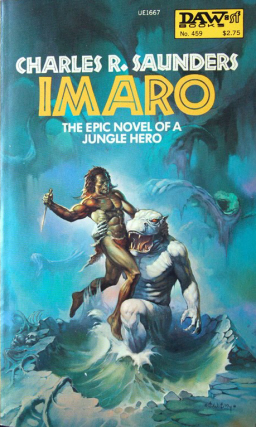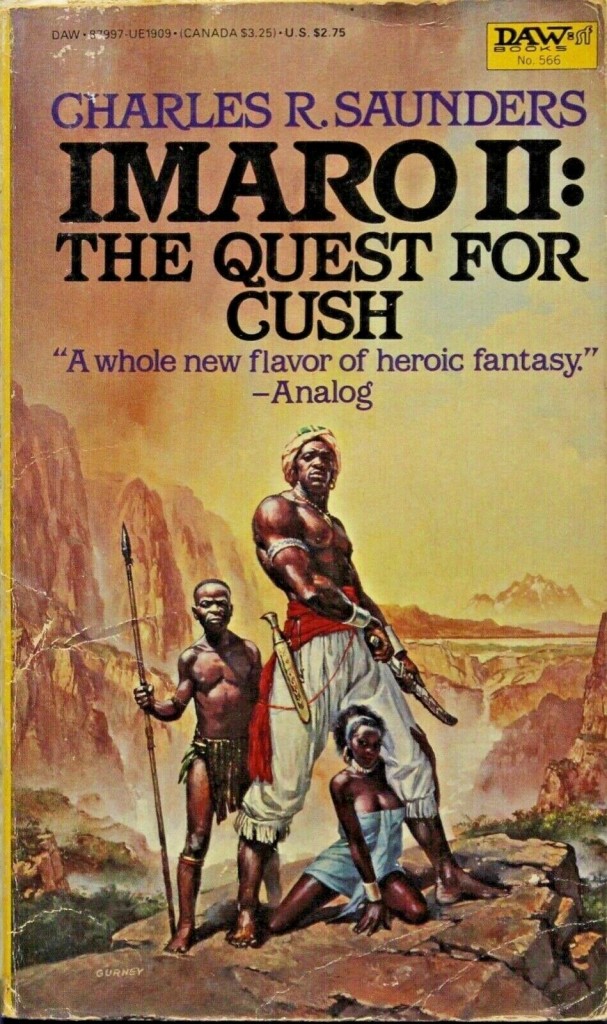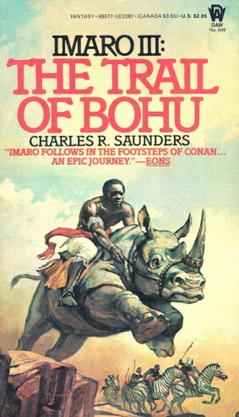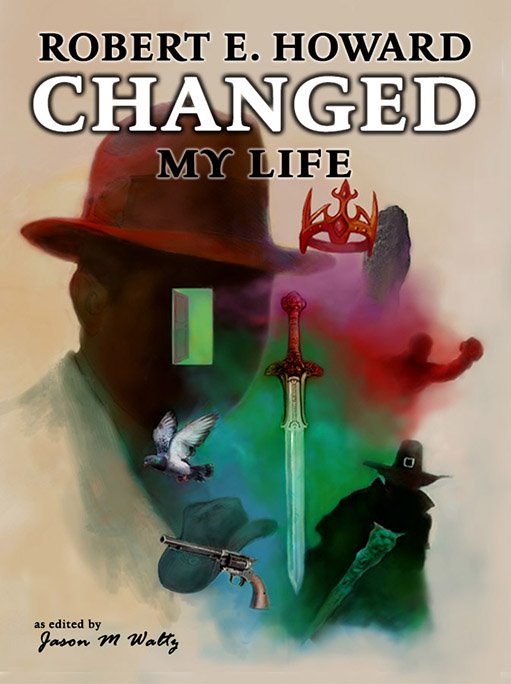Rogue Blades Presents: Charles, My Friend
The following is a memorial article from author David C. Smith for late author Charles R. Saunders.

Charles Saunders and I first began corresponding in 1977, when we were both writing for the semiprozines of the time. He wrote to me first, beating me to the punch, because I admired his work and had considered dropping him a line. As it turned out, I was privileged to know him for more than 40 years. I’ve lost count of the number of letters and emails we shared; unfortunately, all the early letters I received from him are now gone. I stored them in file folders in banker’s boxes that were destroyed when our basement flooded with 30 inches of water in 2001. I joked with him once about that: What will all the historians and fanboys do when they find out that I lost all your letters? There will be no history to write! He told me that he hadn’t held onto my letters, either, so we were even. We did not take it all that seriously. Now, of course, I regret the loss of those letters of his, as well as of his newspaper editorials, copies of which he sent me regularly.
Ironically, we never met in person, although we spoke on the phone just once. I called to bug him for the name and address of his producer at New Horizons, the Roger Corman outfit that had produced Amazons, based on Charles’s story Agbewe’s Sword. This was in 1986. I wanted to get my script Magicians at least read by someone in the business, and Charles was kind enough to help me make the contact, although of course nothing came of my effort.
I don’t recall much of what we discussed in those early letters; mainly it was back and forth musings about our stories, our hopes of seeing them published, and our shared interest in history, as well as our political and social interests, which were aligned. As time went on, we both had middling success with our fiction, seeing some of what we wrote appear as paperback originals. The botched debut of the original edition of Imaro in 1981 by DAW Books hit him hard, although for any of us who know his work, it felt absolutely correct to have Imaro in print from a corporate New York publisher. Imaro was followed by The Quest for Cush in 1984 and then The Trail of Bohu in 1985. And there ended the saga of Imaro, it seemed, at least for a time.
By then, Charles had moved to Halifax, Nova Scotia, from Ottawa, where he had gone in 1969 rather than be drafted to fight in Vietnam. He had been radicalized in the late sixties in Chicago, where he had associated with the Black Panthers — which, despite the image of them propagated by the FBI, were concerned primarily with doing good for, and fighting for justice in, African American communities. He had grown to maturity during days of rage in our country; although he was six years older than I, inevitably, our politics were of a kind: we believed in and supported progressive causes on both sides of the border, especially social justice issues. (In the 90s, a mutual correspondent of ours referred to “feminazis” in a letter to Charles. Imagine his reaction to that.) And he was, I believe, twice married and divorced, something else we had in common.
The move to Halifax turned out to be critically important for Charles. As much as all of us celebrate his fiction and appreciate his creating the Sword and Soul genre, his journalistic work in Nova Scotia fed his soul and reawakened the activist in him, particularly when he began serving as the weekly current affairs columnist at The Daily News in Halifax. George Elliot Clarke, his predecessor in this role at the tabloid, describes it as “a black-focused, public-affairs column” in his introduction to Black and Bluenose: The Contemporary History of a Community, a choice collection of 87 of Charles’s columns from 1989 to 1998. Clarke writes of Saunders:
“A scrupulous publicly-minded and sensitive columnist, Saunders canvassed every problem and accomplishment in what is euphemistically called ‘race relations,’ especially of the black-white variety, that has unfolded in Nova Scotia over the past decade. Of course, given that Nova Scotia was once a slave society (just like Mississippi) and later allowed only segregated educational and employment prospects (just like Alabama), there have been plenty of racial contretemps to address. … Black Haligonians reminded him of his family and friends back in Pennsylvania, and their down-to-earth accent, down-home cuisine, and down-to-soul gospel were uplifting and upstanding. … Following a centuries-old, African-North American tradition, then, Charles came to perform journalism as a protest-oriented, engagé art.” The chapter titles relay the spirit and tone of the contents: “Not in my back yard.” “What’s going on.” “Taking it to the streets.” Charles inscribed my copy, “To Dave – Sometimes I wish all this was fantasy – Charles.” The very real community struggles and occasional victories he reported in his columns were not, alas, fantasy fiction.

Still, this was rather an unsuccessful period in terms of selling fiction. In his letter to me of September 13, 1999, enclosed with the copy of Black and Bluenose, he wrote optimistically that he might be successful in placing Abengoni with Warner Books. An editor there liked what he’d sent but suggested some changes, so “it’s probably better not to send you Abengoni right now. Most of what I’ve already written will still be there, it will just be rearranged.”
I was in a fallow period during this time after having written almost nothing for several years. It was hard work getting back into practice, and I was unsuccessful until I completed Seasons of the Moon, which predictably was turned down by every agent I pitched. I published it myself through iUniverse in 2005. By that time, of course, Charles had seen Imaro released in the classic Night Shade Books edition in early 2006. “If you do a Google search over the Internet for Charles Saunders Imaro,” he told me in his letter of May 27, “you will find that there is a lot of ‘buzz’ over the return of this book. A lot of people are talking about it.” He praised Seasons in that letter, too, and congratulated my wife and me on the upcoming birth of our baby daughter, although, “I can’t really say anything more, as I am not a family man.” In any event, it looked as though we were both on a roll with much to celebrate.
As we know now, however, the Night Shade editions of Imaro and The Quest for Cush, as splendidly produced as they were, did not provide Charles the wider attention and rewards he deserved. Better attuned to the market than I, he came to understand that Black voices were not an easy sell at that period. (I was naïve; I told him I doubted that: surely fantasy and sf readers are among the most liberal-minded and accepting people out there, right?) He wrote to me on August 17, 2007:
Night Shade Books is pulling the plug on Imaro, after publishing only two of the five books.
The reason? Poor sales.
I feel like I’m in a time warp, because that was the same reason my original publisher, DAW Books, dropped the series more than 20 years ago.
I can’t say much more, other than that it is very difficult for me to see my lifelong dream be killed in the marketplace – not once, but TWICE.
He was frank in stating why the books hadn’t sold. The publisher of Night Shade Books relayed what a lot of booksellers told him, that “fantasy is a white realm.”
In retrospect, we can see that Charles was ahead of the curve, just as he had been when he’d originally created Imaro in 1969. It can take the world a long time to catch up to a visionary. He promised in that letter to keep working — “Imaro wouldn’t want me to quit” — and eventually, the tide of the times (and the efforts of hundreds of independent writers and editors) caught up with him, especially once he began working with Milton Davis and MVmedia. The Trail of Bohu came out in 2009, followed by the long-awaited The Naama War. There were Griots, Dossouye, and Damballa, all in 2011. He deservedly won the Pulp Factory Award for Best Pulp Novel of 2011 for Damballa, which perfectly captures the pulp-era mood of the late Thirties. Dossouye: The Dancers of Mulukau. Griots: Sisters of the Spear. Abengoni: First Calling. On and on. The superb collection Nyumbani Tales in 2018.
He was pleased to contribute to the Robert E. Howard biography I wrote over the fall and winter of 2017–2018, but our letters by then more and more had less to do with our writing than with current events. We still boosted each other when, as writers, we fought bouts of depression (something we both dealt with) or writer’s block. But our topics of discussion included George Zimmerman’s murdering Trayvon Martin in 2013, as well as the passing of Nelson Mandela that year. By 2014, we were talking about what, for us, appeared to be a downward spiral in society, and by 2016, it was the results of the U.S. Presidential election. (“How much damage will Trump do… or be allowed to do?”) Canada had gone through a decade of conservative government under Stephen Harper, the “Nixon of the North.” In 2015, Justin Trudeau had become Prime Minister and secured a second term in 2019, albeit with a minority government. But how would the 2020 election go in America?

The past few years also had to do with matters of health. Even though in my mind, when I wrote to Charles, I was carrying around good memories of that early creative period of the 1970s and early 1980s, we were not young men any longer. On September 16, 2018, he apologized for a delay in writing to me with the account of his collapsing outside the drugstore across the street from his apartment. Numbness in the right leg, he said. A passerby and an employee of the drugstore helped him cross the street to sit on the sidewalk and called 9-1-1. The preliminary diagnosis, he said, was a sudden bladder infection accompanied by problems with his diabetes. He was in the hospital for several days and came out with “a laundry list of pills to take,” but he made it back home, shaky but still with us because of the “miracles of modern medicine.”
While in the hospital, he said in that letter, he heard that Aretha Franklin had died. “That news saddened me a great deal. I was a young man during the days of ‘Rap, Retha, and Revolution,’ and I still remember what a heady time that was.” And he asked, “How’s the job? You must be looking at retirement soon. If you can retire on your own terms, that’s great. I’m speaking as one who did not retire on his own terms.” The Daily News had folded unexpectedly in February 2008; 92 staff members were laid off, including him.
The following July came an email: “I am very close to having a deal to get the Imaro stories made into a TV series, a la ‘Game of Thrones.’ It’s just a matter of crossing all the i’s and dotting all the t’s. (ha ha) Until that’s done, it has to be kept quiet. I’ve just been bursting to tell you about it, and I know you’ll keep it secret until it’s OK to let the cat out of the bag. That will hopefully be very soon now.”
All of us are now aware, of course, of this planned series, but last summer and over the winter and into the spring of this year, we kept mum on announcing this event. Of course, Charles died without having had the honor of publicly declaring it to the world.
My last letter to him was May 13, 2020. The Imaro project was a topic but the main subject was his witnessing a racist incident while he was shopping at a Walmart. These events have been happening with increasing regularity on both sides of the border, we lamented. Most of the letter dealt with Trump and the political atmosphere in this country. And, of course, because the coronavirus pandemic had kicked in, I ended the letter with a perfectly sensible, “You take care, my friend.” I knew that he had been living in minimal circumstances for years, and of course his health, “laundry list of pills” notwithstanding, remained a worry.
Charles himself had, for years, ended his letters to me with, “Keeping on.” I’d like to think that he is continuing to do just that now under other circumstances.
Charles’s contributions to his community were great and important. He knew that and was recognized for it. He should be lauded as much for that work as for his singular significance in our field of storytelling. When I think of him and his most notable creation, Imaro, I go all the way back to a passage at the end of “The Place of Stones.” Imaro confronts Mubaku, his grandfather, and Masadu, his enemy. Mubaku lists the wrongs Imaro has committed against the Kitoko, his clan. “These are great wrongs,” his grandfather tells him.
For a fleeting moment then, the Kitoko clan warriors saw what lay beneath Imaro’s impregnable exterior: a hurt child.
Masadu gives his own weapons to Imaro, telling him that the Ilyassai have done greater wrongs to him than he has done to them. They will do him honor if he will return home with them. But he cannot. Imaro takes up the proffered weapons, but then:
His hands opened. Masadu’s weapons fell with a clatter and a clang to the rock-strewn ground. His heart hardened. And the hurt child spoke.

“You did not accept me before,” he said tonelessly. “I will not accept you now.”
The hurt child spoke. What lay beneath Imaro’s impregnable exterior: a hurt child.
Immediately we know that we have here a storyteller who is not going down the rote path of adventure fiction or sword-and-sorcery cliches; Charles is writing excellent fiction with a character — and later, characters — of literary merit. I have read that last-quoted paragraph dozens of times, and I keep coming back to it for that very reason: we have a real person on the page. It is a perfectly written paragraph, and with it, we have the sudden, sharp, immediate recognition that we are in the hands of an artist whose talents will only grow and improve indefinitely. Despite the warrior’s impregnable exterior — a phrase that sounds as though the author is describing a wall of rock, which Imaro is physically — the hurt child spoke. Insight. Character. Depth.
No matter how often we sometimes lapsed in staying in touch, Charles and I sent each other Christmas cards every year. Mine were always something from a boxed collection bought at Target or the drugstore; he, on the other hand, made sure every year to send me a unique one that was comical or goofy. The one from last year had a bunch of lights on a string on a Christmas tree making some jest about another of them named Dave. Where did he find these comical cards? I looked forward to seeing what he would send this year.
In 2006, he inscribed my copy of the Nightshade Books edition of Imaro, “To Dave, Past, present, and future, always a friend. Charles.”
I miss my friend.
David C. Smith (born August 10, 1952, in Youngstown, Ohio) is the author or coauthor of more than two dozen novels and short story collections, primarily in the sword-and-sorcery, horror, and suspense genres, as well as a postsecondary English grammar textbook. Following stints as an advertising copywriter and English teacher, Smith worked for nearly 30 years as a medical editor, including serving 17 years as managing editor of a peer-reviewed orthopaedic journal. He lives in Palatine, Illinois, with his wife, Janine, their daughter, Lily, and their cats, Rosebud and Corabelle. His website is available at http://blog.davidcsmith.net/ and his Wikipedia page is available at https://en.wikipedia.org/wiki/David_C._Smith_(author). His most recent work, and one he is most grateful Charles contributed to, is the REH biography Robert E. Howard: A Literary Biography. David and Charles will appear together in RBF’s Robert E. Howard Changed My Life.
Ty Johnston is vice president of the Rogue Blades Foundation, a non-profit organization focused upon bringing heroic literature to all readers. A former newspaper editor, he is the author of several fantasy trilogies and individual novels.

Ty, thanks for putting this together as you did. Much appreciated.
Wonderful article and remembrance, Dave. I’m sure Charles is smiling down. And he not only encouraged me and my writing, he put me in touch with you. He was the catalyst for so many things, brought so many people together.
Thanks for sharing Dave; inspiring, depressing and beautiful all at the same time. Rest in peace Mr Saunders.
Thanks for sharing David (and Ty). I didn’t know the Amazons movie was based on Saunder’s work. The Roger Corman S&S movies always had great covers… and campy production. I would love to see a serious take on Imaro.
I am sorry to hear of Charles’ passing. I was fortunate to have known him while he lived in Ottawa and was the editor of the Ottawa Science Fiction Society’s fanzine Stardock. I know that he published a couple of stories in that fanzine but at this far removed date can no longer remember if they were Imaro tales. Thanks for sharing.